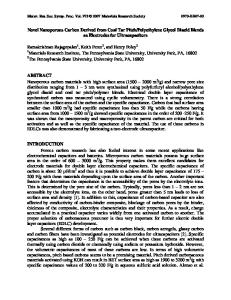Bimodal porous carbon electrodes derived from polyfurfuryl alcohol/phloroglucinol for ionic liquid based electrical doub
- PDF / 717,107 Bytes
- 10 Pages / 584.957 x 782.986 pts Page_size
- 96 Downloads / 326 Views
Chih-Chuan Chou Department of Materials Science and Engineering, The Pennsylvania State University, University Park, Pennsylvania 16802, USA
Ramakrishnan Rajagopalana) Department of Engineering, Penn State DuBois, DuBois, Pennsylvania 15801, USA; and Materials Research Institute, The Pennsylvania State University, University Park, Pennsylvania 16802, USA
Clive Randall Department of Materials Science and Engineering, The Pennsylvania State University, University Park, Pennsylvania 16802, USA; and Materials Research Institute, The Pennsylvania State University, University Park, Pennsylvania 16802, USA (Received 1 October 2017; accepted 16 November 2017)
A hierarchical porous carbon with bimodal pore size distribution was synthesized using pyrolysis and controlled activation of polymer gel derived from furfuryl alcohol and phloroglucinol using a soft templating approach. Symmetric capacitors made using the synthesized carbon electrodes in neat 1-butyl 3-methylimidazolium tetrafluoroborate showed a specific capacitance of 141 F/g at 1 A/g when cycled between 0 and 3.8 V at room temperature. The capacitor also showed 90% capacitance retention over 5000 cycles. Equivalent circuit modeling of impedance spectra was done to monitor changes and provide microstructural details during cycling and temperature studies. Cyclic voltammetry showed the presence of specific adsorption of the electrolyte ions on the carbon electrode and this was in good agreement with strong dependence of specific capacitance on temperature. Such strong interaction along with the nature of electrical double layer formed in the hierarchical porous carbon results in widening the voltage stability window of the capacitor.
I. INTRODUCTION
Room temperature ionic liquid (RTILs)-based electrolytes in electrochemical double layer capacitors (EDLC) are promising alternatives and offer several distinct advantages over aqueous and organic solvent-based electrolytes. These include a wider electrochemical window, higher thermal stability, and nonflammability.1,2 However, the main drawback of RTIL is its relative higher viscosity compared to organic solvent-based electrolytes. Consequently, the charge–discharge rate capability of electrochemical double capacitors (EDLC) made of nanoporous carbon electrodes with an ionic liquid electrolyte is limited due to the severe mass transfer limitation. The ionic transport resistance can be mitigated through the design of the hierarchical pore Contributing Editor: Yat Li a) Address all correspondence to this author. e-mail: [email protected] DOI: 10.1557/jmr.2017.457
structured carbon with appropriate micro and meso pore size. While the presence of ultramicropores is critical to the availability of the large surface area and contributes significantly to the double layer capacitance, dense microporous carbon with no mesoporosity can accelerate the electrolyte decomposition reaction leading to accelerated pore clogging, loss of cycling, and decreased cycle life of the device. One good way to ensure that there is good interconnected
Data Loading...











